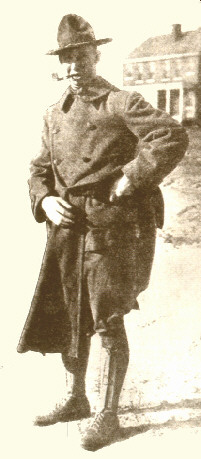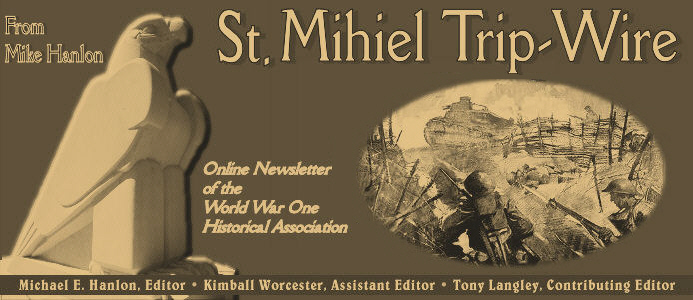 |
Captain Eddie Grant
307th Infantry,
77th Division
KIA October, 1918 |
"Harvard Eddie," as he was known, was the most prominent major league baseball player to be killed in action in either World War. He died on October 9, 1918 in the Argonne Forest and was subsequently buried at the American Cemetery at Romagne-sous-Montfaucon.
From Harvard Magazine:
Edward Leslie Grant '06, LL.B. '09, owns the Harvard record for longevity in the pros. As a collegian, law student, and practicing lawyer, "Harvard Eddie" Grant played in 992 big-league games as an infielder and utility man (including the 1913 World's Series) from 1905 to 1915. He played with the Indians, Phillies, Reds, and Giants.
 Eddie in 1913
|
When war was declared in 1917, Grant, who had attended the Plattsburgh, New York, officer training camp, enlisted and was assigned to the 307th infantry regiment of the 77th Division where he soon rose to captain. On October 5, 1918, while leading a patrol into the Argonne Forest in order to locate and rescue Charles Wittlesey’s "Lost Battalion," (Whittlesey and Grant were friends from Plattsburgh), Grant was severely wounded and died a few days later.
On Memorial Day, May 29, 1921, representatives from the armed forces, baseball, and sisters of the slain Grant, unveiled a monument in deep center field of the Polo Grounds to the memory Captain Edward L. Grant: a professional both on and off the field.
In ensuing years, the plaque became the focal point of annual Memorial Day events. [Baseball season ends before Armistice Day.] After the Giant's last game at that stadium in 1957, the plaque was stolen, regained by the authorities, but then subsequently disappeared. It was never replaced, despite a promise by the Giants management to move it to San Francisco with the team.
Text of Original Plaque
In Memory of Capt. Edward Leslie Grant
307th Infantry-77th Division A.E.F.
Soldier - Scholar - Athlete
Killed in action / Argonne Forest / October 5, 1918
Philadelphia Nationals 1907-1908-1909-1910
Cincinnati Reds 1911-1912-1913
New York Giants 1913-1914-1915
Erected by friends in Baseball, Journalism, and the Service.
In December 2001, two World War One historical organizations approached the San Francisco Giant's Baseball Club with an offer to help raise funds for installing a replacement for Eddie Grant's plaque at the new Giants Stadium. The team's President and Managing General Partner declined the offer. In the subsequent seasons, the Giants blew a sixth game lead and ultimately the 2002 World Series, and were eliminated early in the 2003 playoffs.
Their previous World Series appearances following the loss of Eddie's plaque were also notably odd. In the 1962 rain-plagued series, the last out of the seventh game was a crushing line drive with the Serie's winning runs in scoring position that went as if guided by radar to the Yankees second baseman. The 1989 earthquake-plagued series ended with a four-game sweep by the Oakland A's. The Giants last won a championship in 1954 — three years before Captain Eddie's plaque disappeared. Could there be a jinx or a curse associated with the failure to replace theplaque? Well, it is forty-nine years and counting since a pinch hitter named Dusty Rhodes, a utilityman like Eddie Grant, led the Giants to their last championship.
Postscript: Several years after this article appeared, the Giants finally replaced the plaque at AT&T Ballpark in San Francisco. Although, the plaque is in a hard-to-find location at the stadium [at the New York Polo Grouds it was conspicuously placed in center field] in 2010, after 56 years, the Giants finally won a World Series. Apparently the "Curse of Captain Eddie" has finally been lifted.
Back
|



